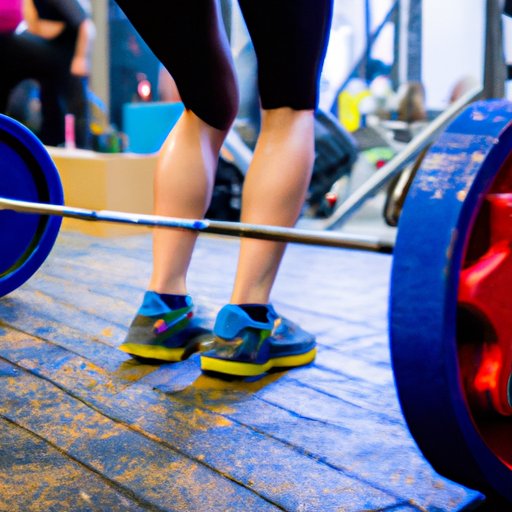Introduction
The deadlift is one of the most popular and effective exercises in any gym-goer’s repertoire. It’s versatile, and can be used to target almost any muscle group. But is deadlift a leg exercise? The answer is yes: deadlifts are an excellent way to build strength and tone in your legs.
The Power of Deadlifts: How to Strengthen Your Legs
To understand how deadlifts work as a leg exercise, it’s important to first understand the muscles involved. When you perform a deadlift, you’re primarily targeting your glutes, hamstrings, quads, and calves. These are all major muscles that are essential for strong and healthy legs.
There are many benefits to training with deadlifts. Most notably, they help to build functional strength and stability in your core, hips, and legs. This can translate to improved performance in activities like running, jumping, and climbing. Additionally, deadlifts are a great way to increase overall strength, power, and endurance in your lower body.
When it comes to deadlifts, however, it’s important to make sure you’re doing them correctly. Common mistakes include rounding your back, using too much weight, and not engaging your core properly. All of these mistakes can lead to injury, so it’s important to make sure you’re using proper form and technique.
A Comprehensive Guide to the Deadlift-Leg Exercise Combo
There are several different variations of deadlifts that you can use to target your legs. The most common type is the traditional barbell deadlift, but there are also options like the kettlebell deadlift, single-leg deadlift, and trap bar deadlift. Each variation targets slightly different muscles, so it’s important to experiment with different types to find out which works best for you.
Incorporating deadlifts into a leg workout is fairly simple. You can do them as part of a full-body workout or you can focus on just your legs. If you’re focusing on your legs, start with a few sets of squats and then move into deadlifts. For optimal results, stick to 3-5 sets of 8-12 reps with a moderate weight.
Is the Deadlift an Effective Leg Exercise?
The deadlift is an incredibly effective leg exercise. While it does target the entire body, it’s especially beneficial for building strength and power in the legs. It’s also a great way to improve balance and stability in the lower body.
That being said, deadlifts aren’t without their drawbacks. They can be difficult to master and require a lot of practice to get right. Additionally, because of the high level of intensity involved, they can be hard on the joints. As such, it’s important to proceed with caution and listen to your body if you experience any discomfort.
When comparing deadlifts to other leg exercises, it’s important to take into account the specific goals you’re trying to accomplish. For example, if you’re looking to increase muscular endurance, squats may be a better option than deadlifts. On the other hand, if you’re looking to increase power and strength, deadlifts are a great choice.

Tips and Tricks for Making the Most of Deadlifts as a Leg Exercise
If you want to make the most of deadlifts as a leg exercise, there are a few things you can keep in mind. First and foremost, proper form and technique are key. Make sure you’re engaging your core, keeping your back flat, and using a controlled motion throughout the lift.
It’s also important to adjust your weight accordingly. Don’t go too heavy too soon, as this can put unnecessary strain on your muscles and joints. Start light and gradually increase the weight as you get stronger.
Finally, it’s important to work on explosive strength. This means focusing on pushing through the lifting phase quickly and powerfully. This will help you get the most out of each rep and ensure you’re getting the most bang for your buck.

Understanding the Mechanics of Deadlifts as a Leg Exercise
To really maximize the effectiveness of deadlifts as a leg exercise, it’s important to understand the mechanics of the movement. Before you even begin the lift, it’s important to engage your core and warm up your muscles. This will help you avoid injury and ensure you’re performing the exercise correctly.
Once you’ve completed the lift, it’s important to take the time to cool down and stretch. This will help your muscles recover and ensure that you’re ready for your next session. Additionally, it’s a good idea to pay close attention to your nutrition and hydration levels. Eating a balanced diet and staying hydrated will help you get the most out of your workouts.
Conclusion
Deadlifts are an incredibly powerful and effective leg exercise. They can help to build strength and power in your lower body, as well as improve balance and stability. However, it’s important to make sure you’re using proper form and technique and adjusting your weight accordingly. Additionally, understanding the mechanics of the movement and taking the time to warm up and cool down properly can help you get the most out of your workouts.
In conclusion, deadlifts are an excellent way to strengthen and tone your legs. With proper form and technique, and by understanding the mechanics of the movement, you can make the most of this powerful leg exercise.
Key Takeaways:
- Deadlifts are an incredibly effective leg exercise.
- Make sure you’re using proper form and technique and adjusting your weight accordingly.
- Take the time to warm up and cool down properly.
- Understand the mechanics of the movement to get the most out of your workouts.
(Note: Is this article not meeting your expectations? Do you have knowledge or insights to share? Unlock new opportunities and expand your reach by joining our authors team. Click Registration to join us and share your expertise with our readers.)
